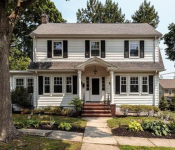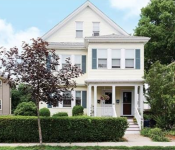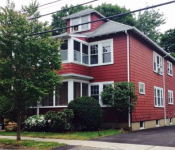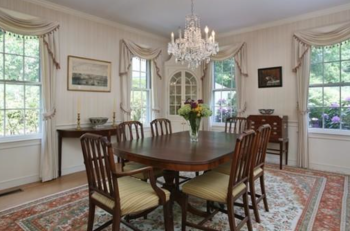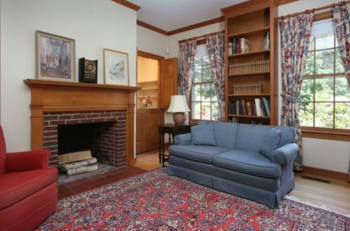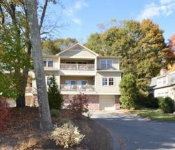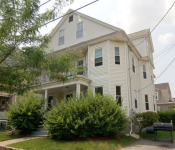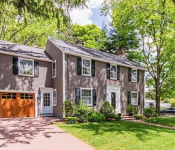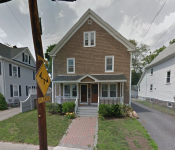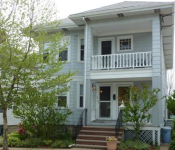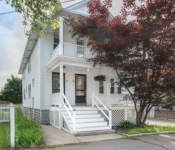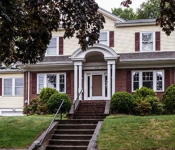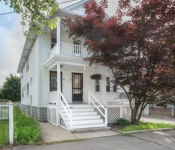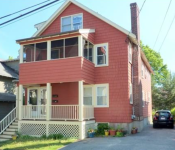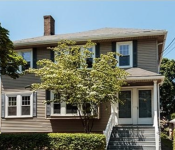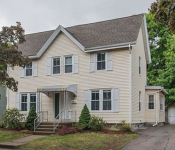Photo: Robert Mahoney with Anne Paulsen at the opening of the Underwood Pool in August.
When asked what Belmont residents should know about Robert Mahoney, the CEO and president of Belmont Savings Bank said that “I’m 67 years old, and I don’t do anything I don’t like any more.”
If there is one thing the Wellesley resident who has spent his entire career in banking wants to do is continue to run one of the best managed community banks in Massachusetts,
“I got the chance to do a job and get paid for something I love to do. How cool is that? I’m the luckiest guy around,” said Mahoney who recently celebrated his fifth year at the helm of BSB Bancorp, Inc. the bank holding company whose subsidiary, Belmont Savings Bank, provides banking products and services.
So far, the former CEO and president of Citizens Bank has used his vast expertise to good results in Belmont. Taking charge in 2010, Mahoney has turned the once sleepy community bank into a well respected regional competitor, tripling the total assets from $400 million to $1.55 billion (as of June), increasing revenues to $10 million in the past quarter with net earnings reaching $1.6 million in the quarter ending in June.
According to analyst web site CapitalCube.com, Belmont Savings is out performing peers institutions such as Wellesley Bancorp, Hingham Institution for Savings, People’s United Financial, and United Financial Bancorp Inc. in areas such as revenue, operating cash flow, and lending in the most recent quarter.
Mahoney also helped convert the 130-year-old institution from a mutual bank to a stock-ownership holding company in 2011. As of Tuesday, Sept. 22, the stock price was at $21.51, about 25 percent high than a year earlier.
In addition to lead the bank to a solid financial footing for future growth, Mahoney has positioned the bank to be the center of philanthropic giving in Belmont. Establishing the Belmont Savings Bank Foundation in 2011 with proceeds from the bank’s conversion in 2011, grants from the $4 million endowment has been used to help build the town’s new pool and varsity court at the Belmont High and sponsor events throughout the year.
The bank has also worked with the Foundation for Belmont Education in the creation of the Belmont Education Rewards account which benefits the FBE and the customer. In total the bank and the Foundation have provided the FBE more than $45,000.
The Belmontonian and Belmont Media Center sat down with Mahoney to discuss his five years at the bank.
Q. In the five years since you were named President and CEO of Belmont Savings Bank, the bank’s total assets have tripled and have made what was once a small community bank into something of a financial powerhouse in MetroWest. Knowing you have a BA in Chemistry from UMass Amherst, what sort of alchemy are you doing to achieve this?
Mahoney: I’ve been very lucky to have been able to go to UMass and learned to do ‘hard’ stuff. Banking is very easy compared to organic chemistry.
Q. You had a long banking career starting at the Bank of Boston than as CEO of Citizens Bank which was a smaller regional bank when you took over which ended up with assets of $11 billion when it was sold.
Mahoney: Citizens in 1993 had four branches in Massachusetts and $400 million in assets, coincidently the exact same size as Belmont Savings Bank in 2010. It was the eighth largest bank in Rhode Island and over the course of 15 years, it became the eighth largest bank in America. It was a lot of fun for the people who worked there because they got to be in a place where their job got bigger just by being there. Banking isn’t always fun, but banking at Belmont Savings is fun.
Q: What in your past experience did you bring to Belmont Savings Bank that has spurred its growth?
Mahoney: I’m a lender. I trained in lending at First National Bank of Boston for 23 years and did all kinds of lending. But more importantly, I know how to get it back. From a technical standpoint, that’s my primary skill. I’m also a pretty decent marketer, I know how to sell stuff and talk to people.
I’ve been doing this for 45 years, so I’d like to think I’ve learned how to get people excited about working at a place, that I can draw a picture what the world could look like if we achieve certain things and how much more fun it would be, and that’s what leaders do. Leaders draw a vision or a picture of a future state that’s better than the current state and get people to run through walls to get there.
Q: So what picture did you give your employees when you came here?
Mahoney: I wanted us to all work at the most admired bank in Massachusetts. I wanted people to go home at the holidays and meet old friends and tell them ‘I work at Belmont Savings Bank’ and their friends say, “Wow, that’s a great bank.” I think it’s great fun to work at an admired corporation. There aren’t many out there. Working for a great company, really admired company is a huge source of physic income.
Q: What areas of banking are you targeting?
Mahoney: So what does most admired mean? First of all, you have to be growing. It’s hard to conceive of a really admired company being static.
When we first got here in 2010, we wanted to get to a billion dollars in assets. A billion dollars is a kind of a rite of passage, an entry point for a good sized admired bank. We wanted to be profitable because anyone can grow a business and not make any money. We wanted to have the services of the big banks but the touch of the community banks; the on-line services, the mobile banking services.
It shouldn’t be a compromise to be a customer of the Belmont Savings Bank; it should be equal or better and deliver the personal touch. Have people answer the phone, say ‘please’ and ‘thank you,’ we have a human being answer the phone, every day every hour.
Q: Belmont Savings is known as a lending bank with an emphasis on residential and increasingly commercial real estate lending. What is your approach towards lending?
Mahoney: Residential home mortgage lending is the fundamental base of any community bank, it’s what really links you to your community. There’s nothing like helping someone buy their first home or refinance it for a better rate.
We wanted to grow faster and we saw an opportunity in the commercial side which we thought there was a void. The big banks were becoming a little less personal and engaging. We had a lot of friends from our prior years in banking who were customers of big banks who came to us to do business with us. Why? Because we do answer the phone and they can talk to the president whenever they want. We treat them like humans. They are our friends. We know how to do this. We’re predictable; when we tell someone we’re going to get a deal done, it gets done the way we said it was going to get done. We’ve put on $500 million in the past five years. This isn’t $50 million condo projects in downtown Boston. These are $2, to $5 million projects so that’s a lot of projects over the course of five years. We do two to three deals of significance a week.
We also do a lot of home equity lending which is terrific for the consumer, it’s a very flexible, tax advantage product where they can pay for a college education or an addition to their house or some other major capital purchase just using their home as equity. We’ve done $150 million of that product.
Q: Belmont Savings is also known for its consumer banking, placing branches in supermarkets and offering competitive rates on products. What’s that segment’s future?
Mahoney: That’s the fuel we use to lend. So if we didn’t have deposits coming in every week, we wouldn’t have the money to lend to our business and real estate customers.
We are very fortunate to have between 50 and 70 families a week switch to us. They come to us from the big banks because they’ve had that final straw that broke the camel’s bank: the ATM card that got eaten up or that surly teller or the 800 number that just wouldn’t talk back.
The supermarkets are a natural place to attract customers because you’re surrounded by strangers all week long. The average bank branch only has customers in it. People don’t go to the bank to go shopping. But they do go to the supermarket and we see them on Wednesday in the meat aisle, Friday in the vegetable counter and we get to know them. We have promotions like spin the “wheel of fortune” to get to win their groceries for free. I had the great pleasure of one of our customers in Cambridge won what we call the ‘whole shebang’ where she got five minutes of free shopping in the Star Market. It was so much fun to watch her rack up six hundred bucks of groceries. What can’t be any better than that?
Everybody wants to have that personal touch. We all have to work for a living but you might as well make something less than miserable and treat people the way you would like to be treated.
You want to create an experience. You want someone to go home to their spouse or their best friend and say, ‘You are not going to believe what happened at the bank today.’ I want that to happen to our colleagues and I want that to happen to our customers.
Q: You’ve had a great five-year run in an industry (community banking) that has been hit hard with narrow margins and competition. What are your plans for the next five years?
Mahoney: I think we can continue to be a better bank in Belmont. We only have 40 percent market share which means there’s 60 percent left to go. We have Newton, Waltham and Watertown and other markets that we’d like to expand. We like the MetroWest area, it’s a terrific place to do business, but an important part of our strategy is to be a community bank which isn’t just making loans and not just taking deposits but giving back to the community.
Q: On that subject, Belmont Savings Bank has been quite generous through its foundation – which has $4 million in its endownment – in supporting or sponsoring a wide range of community projects, from the new Underwood Pool (a gift of $200,000) the Foundation for Belmont Education and Joey’s Park and the new varsity court at Belmont High School. Speak about the bank’s philanthropic direction.
Mahoney: I think giving back to the community is an obligation. It’s not a choice. It’s a reasonable thing to expect from the largest private organization in Belmont, one of the few that has the Belmont name on the door to give back.
I was at the Underwood Pool grand opening and no less than seven or eight different people came up to me and said, ‘I switched banks because of what you did for our town with this pool.’ You get to see people in an environment that wouldn’t have seen them otherwise, whether it’s the holiday party, the Turn on the Town, Town Day with our wonderful car show, the Spelling Bee or the plays. These are opportunities to meet people in a different way, to meet them as a human as oppose to a teller or a banker. We have on average over 4,000 to 5,000 hours of volunteer time in 60 event a year in this town from our 125 employees. But it’s good marketing.
Q: But the foundation’s approach is very hands on, taking the time to meet with recipients, going over plans, learning about the events. Wouldn’t it be more cost effective for the foundation to simply write a check to a few organizations each year?
Mahoney: I think [our current approach] a fantastic use of our time. But we don’t give away money, we invest. We invest in organizations where there is a payback; where we think it’s best for our families in our neighborhoods, it’s best for our students, for getting our visibility out there. I don’t think just sliding checks under the door at midnight is a sustainable model for philantropy. I think there has to be some sort of return; a reputational return, a good will return, a fund for colleagues as part of being the most admired bank. That’s a return for the bank.
